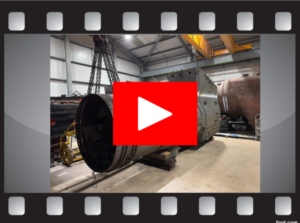Boiler Appeal
Boiler progress as of May 2025
Progress in the restoration of 76077 has been astonishing and, as at the beginning of 2025, the chassis was being made ready for a visit to the Cotswold Festival of Steam on the Gloucestershire Warwickshire Steam Railway (GWSR) – the eventual home of this useful locomotive.
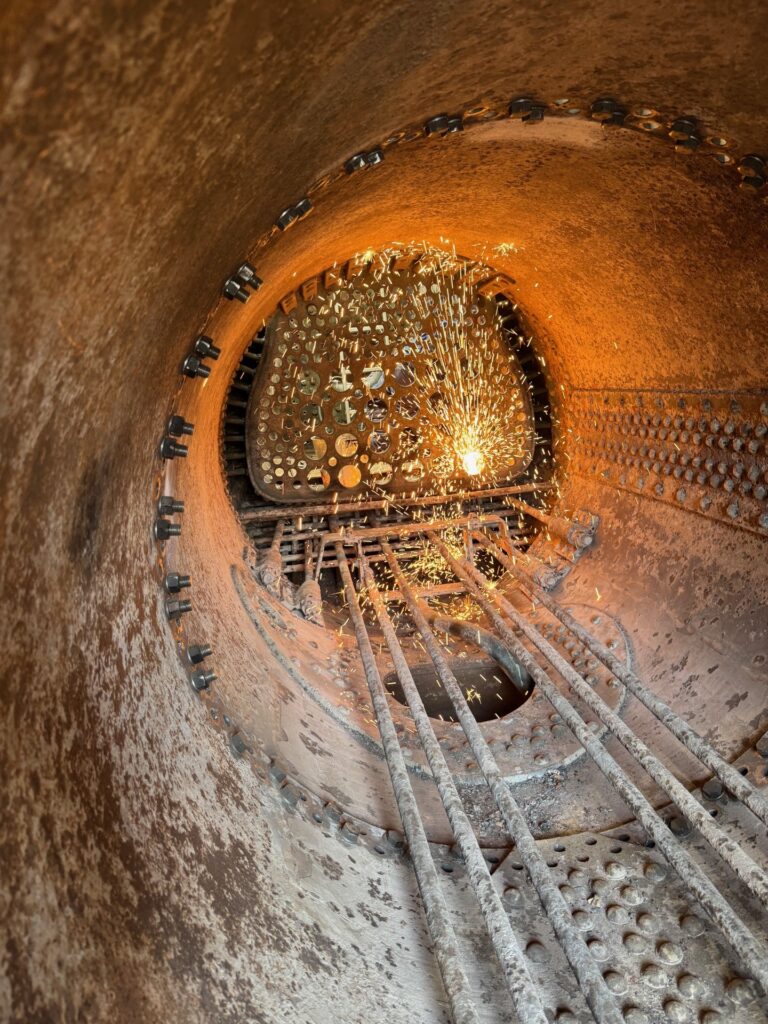
Our major funding focus for 2025/6 is the boiler.
The boiler was dispatched at the end of 2024 to Leaky Finders Ltd in Devon for overhaul and work immediately started, to a specification of work that was expected to be carried out for which £150,000 was budgeted. Part of the work included a non-destructive test (NDT) on the structure of the boiler, to to check for any unexpected hidden flaws that could not be identified when the boiler was first examined in 2021. NDT covers a range of highly specialised analysis techniques to identify the properties of the steel and include magnetic particle, radiographic, ultrasound and eddy current testing.
Unfortunately, the NDT revealed a number of problems including laminations within the steel from which the boiler is made. As work progressed, further problems have surfaced. All of this has led to variations to the repair specification, effectively doubling the original estimated boiler overhaul cost to £300,000. But, to put this into context, it only represents a 20% increase in the overall cost of restoring the locomotive.
The following video provides a more detailed overview of the boiler works to-date and also explains the additional works now required. Pressing the Start Button below will take you to our dedicated YouTube channel.
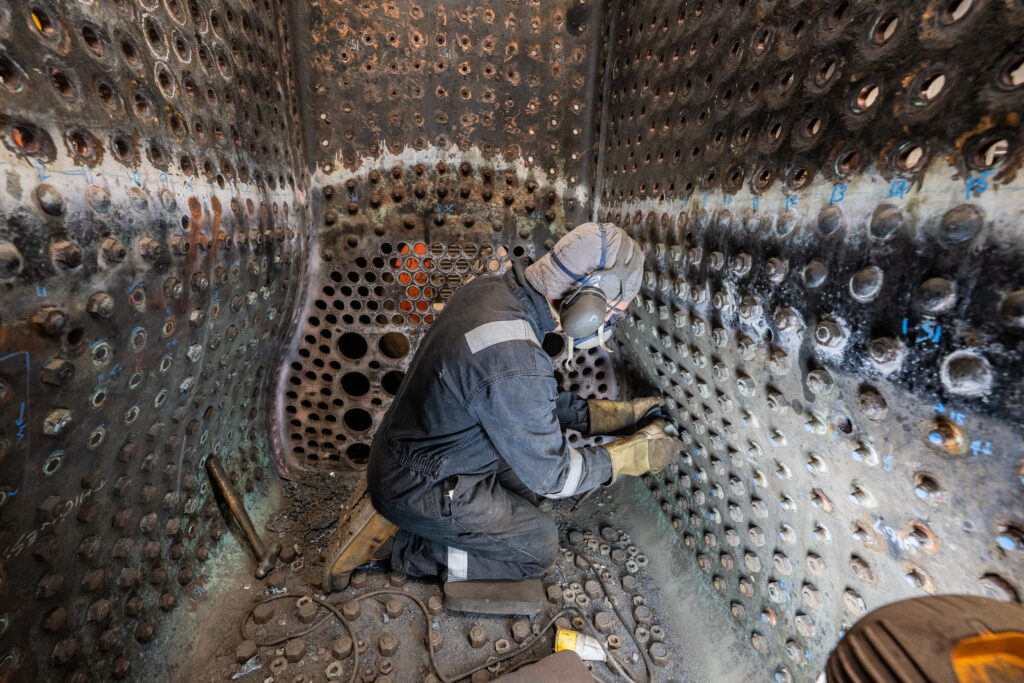
What actually needs to be done?

Following is an explanation of the original specification of the boiler overhaul, along with UPDATES explaining the additional work required.
Original specification: Provide new front parallel section of boiler and new tubeplate
While these could be repaired, the cost of replacing them is not significantly greater and will help minimise work that might be required after the first ten years of operation. The work will also require re-fitting of the longitudinal says and main steam pipe, fit new studs to attach the superheater and fit washout plugs.
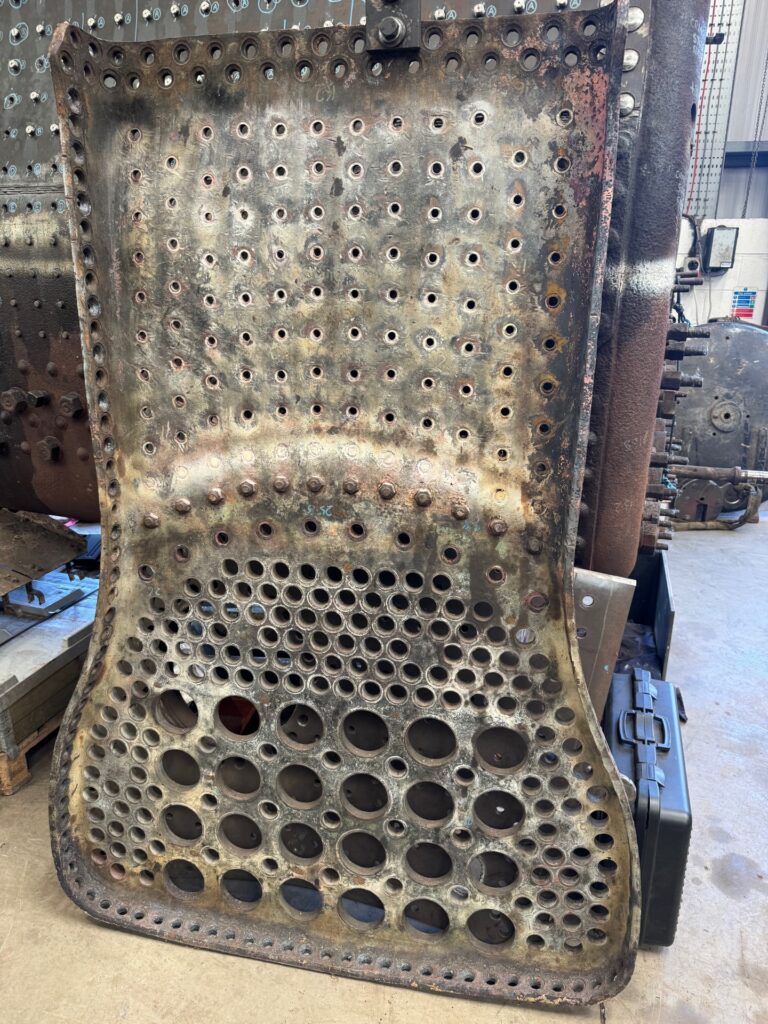
Original specification: Tapered boiler section and dome
There is some corrosion pitting at the bottom of the barrel which can be repaired by welding. The dome cover needs refinishing and fitted with 24 new studs to secure it. The regulator to be overhauled and re-fitted. Several wasted rivets need replacing and new washout plugs fitted.
Original specification: Foundation ring
Replace foundation ring rivets; replace ashpan and grate carrier studs and re-caulk copper and steel plate work. As at May 2025, the foundation ring has been removed.
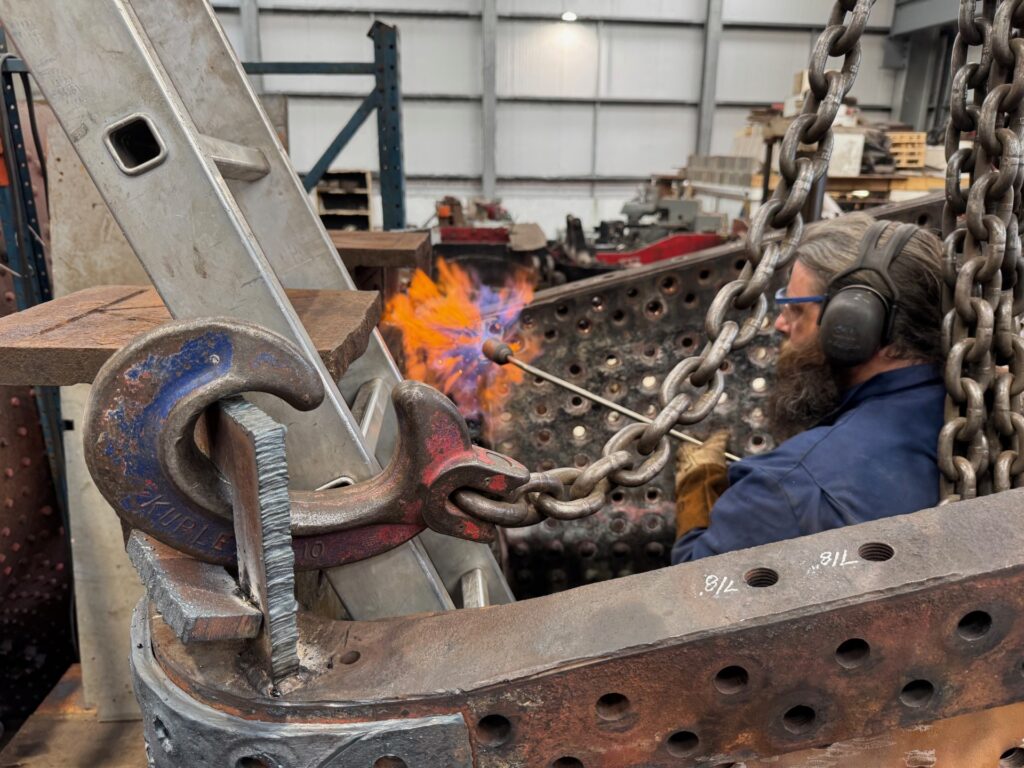
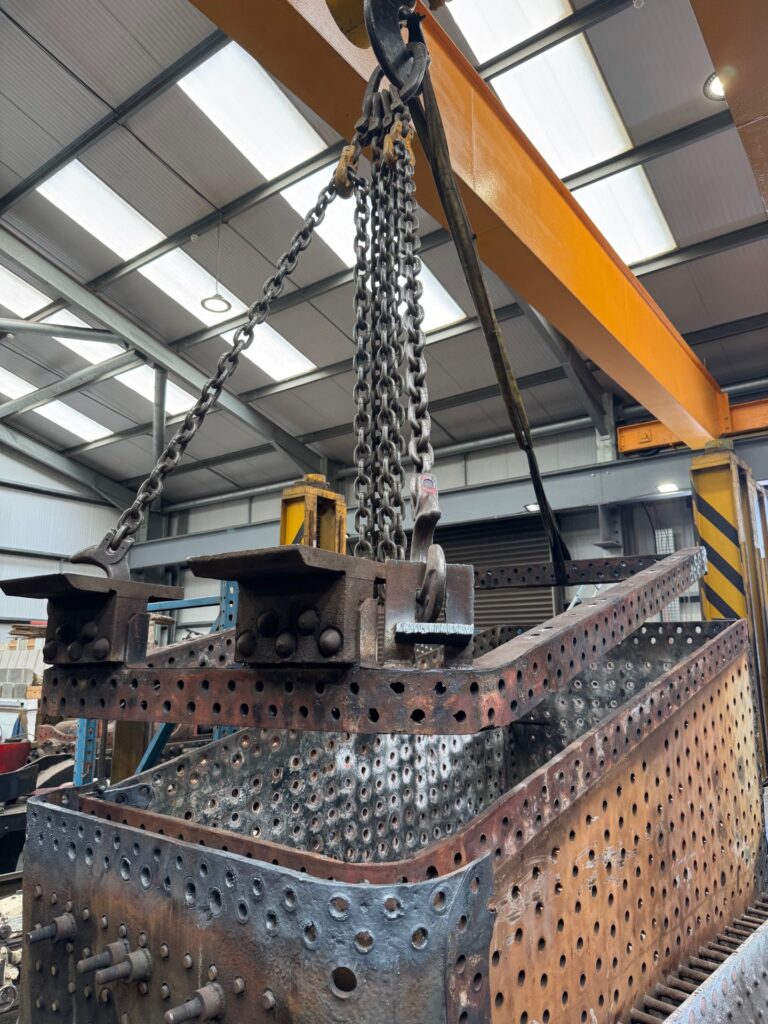
Original specification: Outer firebox throat plate
Cut out and replace corroded platework from the front bottom corners, fit mud hole doors and washout plugs, fit new Monel metal stays as necessary.
UPDATE: The steel from which the boiler is built was found to have many more laminations than can be expected in a boiler of this age (to find out more about laminated steel, follow this link). This has led to little choice but to fit it new steel firebox sides and much of the throat plate (the plate at the front of the firebox, beneath the boiler barrel) to a point in the existing steel where laminations can be avoided.
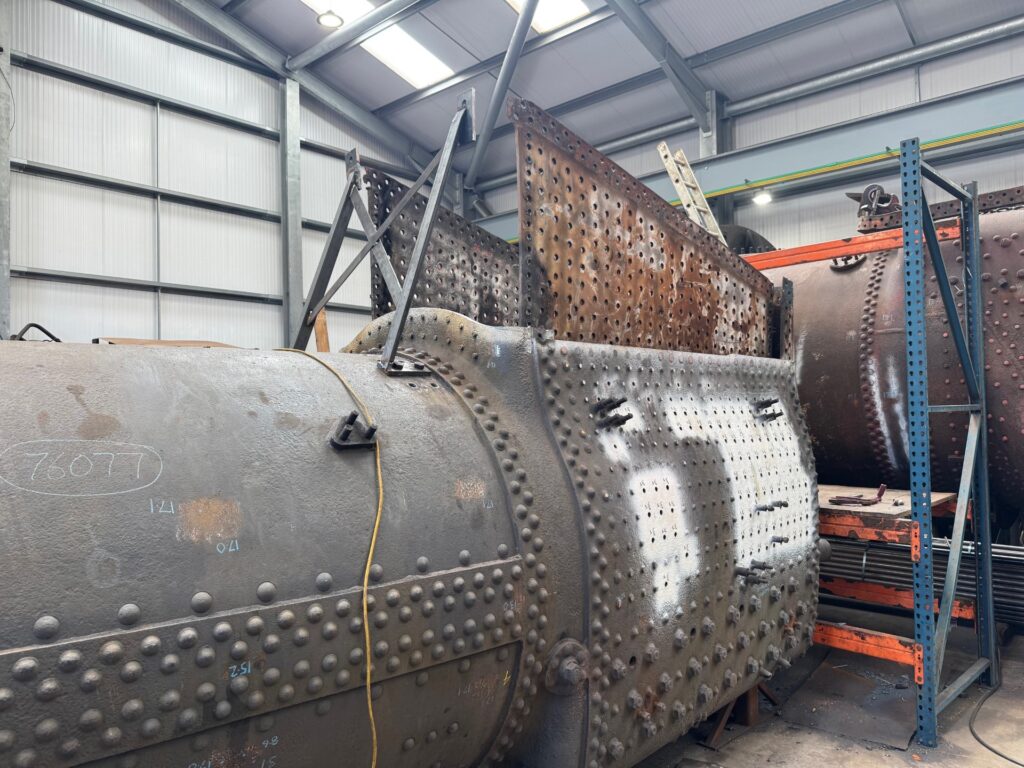
Original specification: Outer firebox side sheets and top wrapper
Replace washout plugs and mud hole doors. Refinish safety valve pads and fit replacement studs, similarly with the manifold pad.
UPDATE: As mentioned above, new outer firebox half-sides will have to be fitted to overcome the problem with laminated steel. In the process of removing the sides, most of the copper stays fitted in 1964 have been sacrificed and need replacement while the NDT revealed that many of the Monel metal stays are broken or flawed. These stays also need replacing. Some of the roof stays also need to be replaced.
Original specification: Firebox backhead
Refinish the pads for backhead boiler fittings, fit new studs for other boiler mountings such as steam brake, gauges and firehole door runners.
Original specification: Copper firebox
Replace rivets and patch screws on lower lap joints; build up edges of the copper lap near the grate and replace the Monel metal stay nuts on the upper section of the tubeplate and elsewhere as necessary; repair existing copper stay heads; replace crown stay nuts, re-cut fusible plug holes and fit fusible plugs.
UPDATE: It has been found that many of the copper stays were near to or at maximum size (1.25in) and there is some ‘star’ cracking around many of the stay holes, which was not evident until the stays were removed. Consideration has been given to both repairing many dozens of holes by copper welding or replacing the lower part of the copper side sheets and it is felt that the latter course will be a more cost-effective long-term solution. On the positive side, however, the copper tubeplate has been replaced, probably at Eastleigh in 1963/64: it is in extremely good condition. But when it was made many of the holes drilled in the lap joints to secure it to the copper firebox sides did not match the holes of the firebox side seams. The holes were fairly crudely re-filled with copper weld and re-drilled to fit. It has been decided to replace the lap seams to avoid any potential future problems that might occur with the original repairs.
Original specification: Tubes
Supply and fit 156 smoke tubes and 24 flue tubes.
Original specification: Hydraulic and steam tests
Carry out these tests for the boiler inspector.
Original specification: Superheater
The existing superheater elements will be refurbished if possible, or replaced, and fitted following the hydraulic and steam tests.
Current status of the boiler (May 2025)
The tube plate was removed at an early stage of the overhaul while the rivets securing the front boiler barrel were removed and temporarily replaced with bolts (this eases movement of the boiler while work elsewhere continues until the new barrel is fitted). The foundation ring has been removed. The steel firebox sides and throat plate have been cut out which revealed that the copper stays (fitted to the lower half of the firebox) were at or close to maximum size (which is 1.25in) and that there is star cracking around many of the holes in the copper inner firebox. New copper for firebox sides have been ordered (the specification of firebox copper can now only be obtained from South Africa). The firebox tube plate has been removed.
Meanwhile, the new tube plate and front barrel section have been made and delivered to be fitted, the throat plate has been pressed and the new outer firebox steel is also available. The boiler is at present upside-down which enables work on the firebox to be carried out.
Timescale
The aspiration of the team has long been to see the engine running for its 70th birthday, which is 28 December 2026 (the date that the locomotive emerged from Horwich Works in 1956). While in theory the additional work could be completed and that aspiration achieved, the likelihood is that completion will slip by a few months into 2027, which will be 60 years since the boiler was last steamed. Some of the delay can be accounted for by long lead times for delivery of the right specification of copper for the firebox, for example. And of course a timely completion of this additional work is dependent on funding.
Funding
The original cost of overhaul of the boiler was estimated to be in the order of £150,000 (including some contingency) and this has doubled to £300,000.
We welcome investments into the boiler fund of a minimum of just £20 per month or a minimum lump sum of £120.
Contributions can be made by standing order with a monthly minimum of £20, by a lump sum or by sponsoring one of the many new boiler components required. Either investment will be acknowledged with both a share certificate and a certificate recognising your contribution towards overhaul of the boiler.
What to do now?

You can make an immediate investment now which entitles you to regular communication from the team; the occasional magazine The Toddington Standard and the opportunity to get practically involved should you wish. You’ll be invited to our annual Open Day too as well as an invitation to ride behind 76077 when she enters service on the GWSR.
Download and complete the Boiler Appeal Share Application Form and if you are paying monthly, the Bankers’ Order form.
We have a range of boiler specific components of varying costs that can be sponsored. A full list of all our available Components and descriptions can be downloaded here. A specific Boiler Component application form can be downloaded here.
A copy of our ‘76077 Boiler Overhaul’ brochure can be seen below. If you would like a copy by post, email info@standard76077.com
Please wait while flipbook is loading. For more related info, FAQs and issues please refer to DearFlip WordPress Flipbook Plugin Help documentation.

